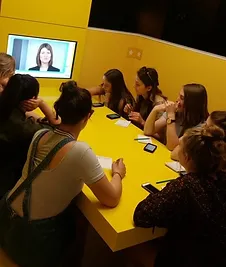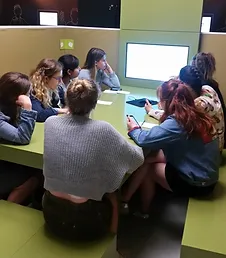July 20, 2018
Written by Diana Spencer
Thoughts from the Liberal Arts and Natural Sciences Dean
 “The last five years have been exciting times for Liberal Arts and Natural Sciences at the University of Birmingham. With two cohorts now successfully graduated, this makes for a very good moment for reflection.
“The last five years have been exciting times for Liberal Arts and Natural Sciences at the University of Birmingham. With two cohorts now successfully graduated, this makes for a very good moment for reflection.
As Dean, I spend my time between getting better to know and support our students, thinking strategically about where our developing organisation can lead us — and into what new partnerships and opportunities — and working on the nuts and bolts of staffing and our physical resources. All these things are interconnected, but also have their own energies and dynamics.

We are a complex organisation, and in our cultural programme, our rich suite of extracurricular activities (including our overnight trips, which take a lot of planning!), our international band of affiliate students, and our strong links into the academic practice of every one of the University’s disciplinary Colleges, sometimes it’s hard for students and graduates of LANS to keep track of all our achievements. So let me outline some of our current highlights, and our plans for 2018/19.
It remains the case that each of our students graduates with a unique programme of study. Reflect for a moment on that: the enormous flexibility enshrined in LANS genuinely enables all our students to craft something brand new and personally meaningful, drawing on the cutting-edge research from across our truly comprehensive university. When we started out, even I found it hard to appreciate how remarkable that would be in practice.

As our graduates know, with four years of LANS under their belts, and for some of them, a year of further study, employment, or other activities, the importance of reflective practice within LANS is paramount, and continues to shape our ongoing development of our core compulsory and optional modules.
Reflection and in particular, learning through trying, failing, reflecting, evaluating, and moving forward through these cycles, is as central to our educational philosophy as it is to our research expertise, and to the entrepreneurial activities of those with whom we collaborate. Our academic faculty, students, and our professional services team, share these goals, and work with the University and other stakeholders to achieve them.
It is in no small part due to this collaborative ethos that we continue to receive resource investment from the University, and collegial support from and within the shared aspirations of Liberal education programmmes within the UK and globally. It’s in all these contexts that we thrive.

Our pioneering cohorts will recall that the LANS academic team was originally composed of many staff seconded to us temporarily on small proportional percentages, and whose ‘main’ role was based in a disciplinary department. This was ideal in many ways, as it gave us breadth across the University, and also provided flexibility. We really had no idea of numbers of students or what it would be like, in reality, to deliver the programme in those early years…
By 2017, it was clear that LANS was recruiting increasingly well – strong numbers, growth in interest, and exceptional students. This made the temporary nature of most of the personal tutors’ roles with LANS increasingly hard to manage: good colleagues were in demand in their ‘home’ departments just as much as they were in LANS, and the pressures on their time and ability to manage the split looked set, eventually, to eat into time that could otherwise have been spent creatively working with students on academic outcomes.

Moreover, although when we started we had a ‘support’ team of just one (Ruth Johnson), we had already anticipated the new scale we were developing by successfully recruiting additional enthusiasts to the office team (compliments to Neil Nelson and Mary Ann Clarke!).
So from September 2018, this wonderful backbone will now grow further, with the permanent addition of Graham Davies, and another administrator to join Mary Ann.
Professional services’ support is one key piece in the jigsaw, but there’s more to the outcomes of this strategic planning. We know how much students value continuity within all elements of the team. We began to address this, redefining our faculty model, by recruiting two new full-time LANS academics in 2017 (Mircea Scrob and Simon Scott) — their roles, working in particular on our core modules’ ongoing refinement and delivery, has been transformative, and they have brought a freshness of vision and energy that we have all relished!
This investment programme also delivers five new academic colleagues, to be known as Lecturers in LANS and x, with ‘x’ a subject area supported by one each of the five university colleges. These new permanent faculty members will be 50% based in LANS. We are extremely excited by this development and the confidence that this resource shows in us as a team (staff and students).
Thus in September 2018 we expect to welcome a new lecturer to Birmingham, shared with the College of Engineering and Physical Sciences, and with a mission to focus on public communication of sciences outside the academy. In addition, we will be joined by an expert in interdisciplinary Humanities, whose background in SportEx, History, Conflict Studies, and expertise in languages (and organising study abroad programmes), will make him an excellent new colleague for our new shared Lectureship connecting the College of Arts and Law with LANS, again, this is a 50% LANS proportion, and as a permanent lectureship. September 2018 also sees our current Director for Natural Sciences, Julia Myatt, add to her portfolio by taking on our 50/50 new lectureship in LANS and Biosciences (representing the College of Life and Environmental Sciences).

In autumn 2019, we will increase by two further permanent shared lecturerships, linking us with the College of Medical and Dental Sciences, and the College of Social Sciences.
But where will we fit these new team members in? We have successfully bid to relocate to a fantastic new suite of rooms. It’s still in our home — the European Research Institute building, but better because bigger and configured specifically as we want it. Some readers may know the exciting open plan flexible-learning space from our Applicant Visit Days – this whole area (including offices, social-, and meeting-space) will now be the LANS Staff and Student Hub, more than tripling our current home. This means that tutors will at last able to be deeply integrated into the spatial dynamics of the community, and more dedicated space can be provided for LANS students to work and socialise in groups, and consult with the LANS student administrative, wellbeing, and experience teams.
This autumn, I myself will become a little semi-detached for a year to give me time to get my next major research project off the ground (my current project, a book about the politics of language change in the late Roman Republic – first century BCE – will be published shortly, Research-in-progress updates will be appearing on my blog: https://dianajspencer.com). After four years as Dean, it’s really important that my research has some space to take shape and for me to produce some preliminary results. Just as we are challenging our students to work interdisciplinarily, we are modelling that behaviour ourselves as academics. I’ll be sending dispatches (and maybe a blog post) about my progress by the end of the year…

For this reason, I am delighted that Julia Myatt will spend the 2018/19 academic year as Dean (we will have a temporary colleague covering for Julia’s work as the LANS NatSci lead, but under Julia’s watchful eye) – I will also be popping in every now and again, generally keeping my ideas and assistance in the mix, and I hope that all of our graduates will continue next year to keep in touch with me, as well as with the rest of LANS!
I will return to the position of Dean in September 2019, and am looking very much forward to that new term of office already!
Finally, we are also in the process of setting up an Advisory Board, comprising internal and external members, and our graduates, to guide LANS through its next phase of development and to advise on strategy — keep an eye out for more communications, and more reports on forthcoming adventures as we look forward to 2018/19…”












 Bourne taints the elements of the story that are usually depicted as pure and good, dimming them somewhat with darkness. For example, the Prince is an injured RAF pilot, seemingly traumatised from the war, the fairy god-mother figure is an ambiguous phantom-like character who seems to have both good and evil qualities, and the notorious ball is set in the Café de Paris- a venue that hosted and still hosts a range of performers, but during the Second World War was bombed causing a number of fatalities. This intriguing mix of good and evil is a fitting reflection of the war. The prince-like character as an RAF pilot highlights the glorification of fighting for your country. Yet, this status came with a price- leaving many survivors traumatised, shell-shocked and injured. Still, this glorification is present throughout the entire performance, including the other male characters dressed in uniform, as all the women in the piece clearly want their attention. However, this idealistic image of a war hero is shattered when you consider the brutal and murderous nature of war. This conflict in honouring the men who went to war and showing the reality of it is depicted in Wilfred Owen’s poetry. Although Owen was a soldier in the First World War, the messages he conveys are still extremely relevant, particularly the preface we wrote to his poetry anthology:
Bourne taints the elements of the story that are usually depicted as pure and good, dimming them somewhat with darkness. For example, the Prince is an injured RAF pilot, seemingly traumatised from the war, the fairy god-mother figure is an ambiguous phantom-like character who seems to have both good and evil qualities, and the notorious ball is set in the Café de Paris- a venue that hosted and still hosts a range of performers, but during the Second World War was bombed causing a number of fatalities. This intriguing mix of good and evil is a fitting reflection of the war. The prince-like character as an RAF pilot highlights the glorification of fighting for your country. Yet, this status came with a price- leaving many survivors traumatised, shell-shocked and injured. Still, this glorification is present throughout the entire performance, including the other male characters dressed in uniform, as all the women in the piece clearly want their attention. However, this idealistic image of a war hero is shattered when you consider the brutal and murderous nature of war. This conflict in honouring the men who went to war and showing the reality of it is depicted in Wilfred Owen’s poetry. Although Owen was a soldier in the First World War, the messages he conveys are still extremely relevant, particularly the preface we wrote to his poetry anthology:
 However, the scene that followed was by far my favourite:
However, the scene that followed was by far my favourite:







